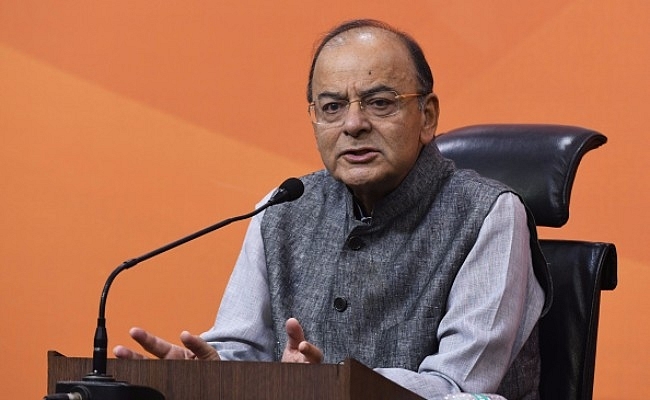Economy
Two Cheers For India’s Banking Stimulus... And Why I Held Back The Third One
- V Anantha Nageswaran rates the banking stimulus and identifies the areas where it fell short.

Finance Minister Arun Jaitley addresses a press conference. (Mohd Zakir/Hindustan Times via Getty Images)
On the evening of 24 October, the Finance Minister of India made several announcements. The key ones are the amount of money being allotted for recapitalising public sector banks and for a ‘Bharatmala’ highways project. The documents that the Finance Ministry had put together for the announcement can be found here and here.
There is plenty of confusion and misunderstanding in the public domain about the bank recapitalisation initiative the government had announced – deliberately or otherwise. The amount announced was Rs 2.11 trillion (Rs 2.11 lakh crore). Of this, Rs 760 billion (Rs 76,000 crore) is already in the works. The government has to come up with Rs 180 billion (Rs 18,000 crore) and banks have to raise Rs 580 billion (Rs 58,000 crore) by issuing shares. The latter would dilute government stake.
The government had announced, as part of the ‘Indradhanush’ programme, recapitalisation of Rs 70,000 crore. Of this, Rs 520 billion (Rs 52,000 crore) has already been provided to banks. The balance will come out of the budget provisions in the coming two years.
The banks were told to raise Rs 1.1 trillion (Rs 1.1 lakh crore) of equity capital themselves. They have raised Rs 212 billion (Rs 21,200 crore) as capital. The government now expects them to raise another Rs 580 billion (Rs 58,000 crore). Not the balance Rs 888 billion (Rs 88,800 crore).
That is how one gets to the figure of Rs 760 billion (Rs 76,000 crore).
The balance Rs 1.35 trillion (Rs 1.35 lakh crore) will be raised by the government from the banks themselves so that the government can provide equity capital to the banks. The Government of India (or an entity chosen by it) will issue these bonds to banks. Banks will subscribe and the government, using the proceeds raised from the bond issuance, will subscribe to banks’ equity.
In other words, the government borrows to invest in stock. This is ‘investing on margin’. Replicating a call option. Hence, the returns to the government could be high if PSU bank stock prices rise after this announcement.
Banks are flush with cash from the money raised during the demonetisation exercise and hence they should have no difficulty in subscribing to the recapitalisation bonds and earning some decent interest income too on it.
Some more information is available on the mechanism of ‘recapitalisation’ bonds in this informative article by Aarati Krishnan in Business Line from February 2016. Recapitalisation bonds will not add to the fiscal deficit, but the interest payments will. But then, the government might earn enough through dividends from banks and through higher taxes from an improved economy that the recapitalisation of banks could bring about.
Apparently, according to the International Monetary Fund, recapitalisation bonds will not count towards gross general government debt either.
On ‘Bharatmala’ and other infrastructure programmes, the fiscal implications are not clear. The impact may be spread out over a few years. What is going to be spent this year might be already provided for. So, one cannot assume that all of it is incremental fiscal spending and that too in 2017-18 itself.
I would give this ‘stimulus’ a total of 2.0 cheers.
One cheer for non-bank related stimulus.
0.5 cheer for bank recapitalisation. (0.5 cheer not earned due to the delay in coming to this point. Three years is too long to wait for a resolution to banking bad debt crisis, especially when the debt capital market for India’s private sector is not well-developed).
Another 1.0 cheer not earned by the government for lack of reforms in the governance and regulation of government-owned banks. As this CPR research note says (co-authored by the current vice-chairman of NITI Aayog), the government had issued some 84 circulars to banks owned by it, between 2012 and 2014. Incidentally, this research note, written in January 2016 – after the government announced the ‘Indradhanush’ programme – records that the government’s programme was not bold enough. I quite agree.
Dr Y V Reddy has an extensive discussion on public sector banking in his book Advice and Dissent and had also spoken at length about the issues both when he was a deputy governor at the Reserve Bank of India and then a governor. See my blog post here for some of his ideas.
A bonus 0.5 cheer for the announcement that public sector undertakings would have to mandatorily become part of TReDS (this is factoring and bill discounting that would get working capital into SME (small and medium enterprises) faster with banks buying the dues from bigger firms). To know more, see my blog post.
This piece was first published on the writer’s blog, The Gold Standard, and has been republished here with permission.
Introducing ElectionsHQ + 50 Ground Reports Project
The 2024 elections might seem easy to guess, but there are some important questions that shouldn't be missed.
Do freebies still sway voters? Do people prioritise infrastructure when voting? How will Punjab vote?
The answers to these questions provide great insights into where we, as a country, are headed in the years to come.
Swarajya is starting a project with an aim to do 50 solid ground stories and a smart commentary service on WhatsApp, a one-of-a-kind. We'd love your support during this election season.
Click below to contribute.
Latest